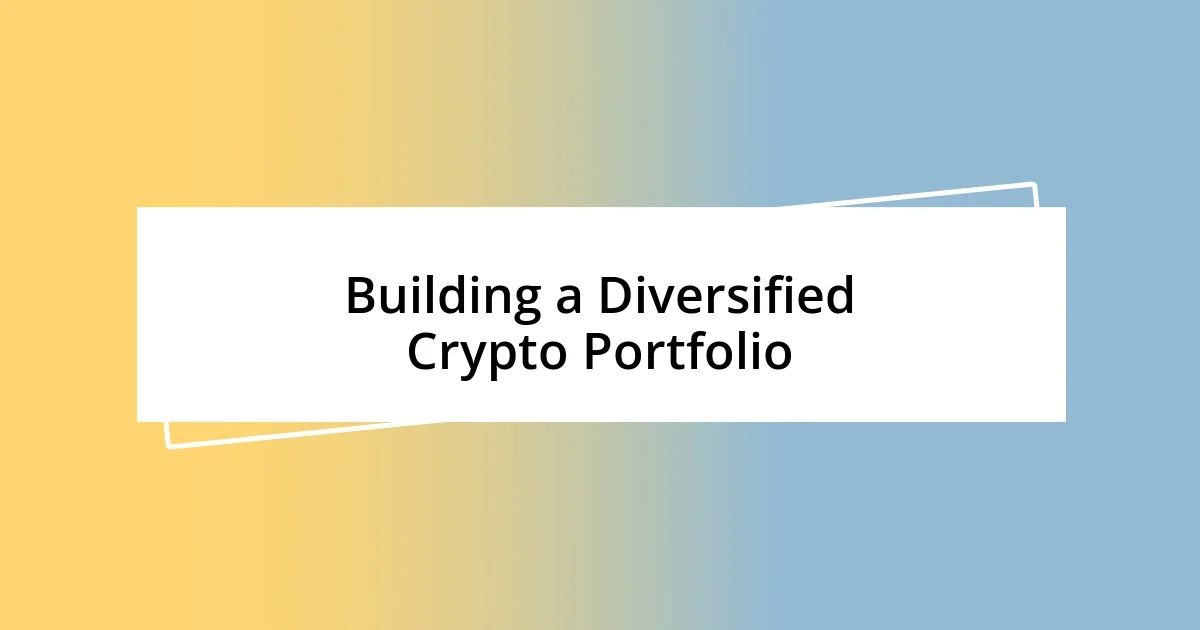Key takeaways:
- Long-term crypto holding (HODLing) requires patience, understanding of projects, and the ability to withstand market volatility.
- Strategies for successful long-term investing include thorough research, diversification, and setting predefined exit strategies to manage emotional responses during downturns.
- Being aware of tax implications and keeping meticulous records can significantly ease the process of managing investments and optimizing tax burdens over time.

Understanding Long-Term Crypto Holding
Long-term crypto holding, often referred to as HODLing, is a strategy where investors buy cryptocurrencies and hold onto them for an extended period, regardless of market volatility. From my own experience, this approach demands not just patience, but also a deep understanding of the projects behind the coins. I often ask myself, “Can I believe in this technology long-term?” – and the answer usually guides my investment choices.
One of the most significant emotional challenges of HODLing is resisting the urge to react to short-term price fluctuations. I remember when Bitcoin dipped dramatically a few years ago; I felt a mix of panic and doubt. Yet, staying the course and focusing on the potential future of blockchain technology helped me see the bigger picture. It’s about having faith in the fundamentals and that sometimes requires a mental shift away from the noise of market speculation.
Understanding long-term crypto holding also means staying informed about market trends and technological advancements. This knowledge feeds into a proactive mindset where I continually reassess my positions. Do I remain aligned with my original investment thesis, or has anything changed? It’s crucial to evaluate these questions as the crypto landscape evolves, ensuring that my long-term strategy stays relevant and grounded.

Reasons to Consider Long-Term Holding
Investing in crypto for the long haul can be a rewarding endeavor, providing a sense of stability amidst the chaos. One of the primary reasons I consider long-term holding is the potential for substantial growth that often comes from staying invested over time. For instance, when I first purchased Ethereum, it was during a dip, and I recall feeling uneasy about my decision. However, years later, I found that having held onto it, not only did my investment grow significantly, but my understanding of Ethereum’s utility in decentralized applications reinforced my belief in its long-term value.
Here are some compelling reasons to explore long-term holding:
- Potential for Higher Returns: Historically, some cryptocurrencies have shown exponential growth over multiple years.
- Compounding Gains: Holding assets over time can lead to compounding returns, similar to traditional investments like stocks or mutual funds.
- Less Stress: Long-term investors often avoid the stress of daily market monitoring and emotional decision-making.
- Understanding Projects: Maintaining a long-term perspective allows for deeper insights into the projects backing cryptocurrencies, which can build conviction and trust in their potential.
- Tax Advantages: In some regions, long-term capital gains are taxed at a lower rate compared to short-term gains, benefiting thoughtful investors financially.
By committing to a long-term strategy, I’ve learned to view dips in the market as opportunities rather than setbacks. It’s a reminder that investment is not just about momentary gains, but about participating in an evolving technological landscape.

Choosing the Right Cryptocurrencies
When it comes to choosing the right cryptocurrencies, I always emphasize the importance of thorough research. I recall my early days of investing when I hastily bought tokens based on social media buzz. Unfortunately, that led to some regrettable losses. Now, I make it a point to dive deep into the fundamentals, analyzing the project’s team, use case, and market potential. This allows me to feel more confident about my investments and helps me avoid the pitfalls of speculation.
Additionally, I consider the community and the overall ecosystem surrounding a cryptocurrency. For instance, I’ve personally seen how a strong community can significantly influence a project’s success. The excitement and support from like-minded individuals can create a positive feedback loop that enhances a coin’s value over time. By engaging with these communities, I not only gather insights but also feel part of something bigger, strengthening my resolve in long-term holding.
Lastly, I pay attention to the crypto’s historical performance and market trends. Analyzing past movements can provide invaluable perspectives on how a cryptocurrency may behave in the future. I remember studying Bitcoin’s price trends during various market cycles, which taught me that patience truly pays off. Notably, understanding past behaviors helps me set realistic expectations for growth, further solidifying my long-term strategy.
| Criteria | Considerations |
|---|---|
| Project Fundamentals | Research the team, technology, and mission behind the cryptocurrency. |
| Community Support | Look for robust community engagement and active development. |
| Historical Performance | Analyze price movements and market trends over time. |

Setting Up a Safe Wallet
One of the first steps in creating a safe wallet is choosing the right type. I personally favor hardware wallets, as they store your cryptocurrencies offline and provide an extra layer of security against hackers. I remember the peace of mind I felt when I first moved my assets from an online exchange to a hardware wallet—it’s like securing my valuables in a safe rather than leaving them out in the open.
As I set up my wallet, I noticed how important it is to generate a strong, unique password. Initially, I used simple phrases, thinking they were enough, but I quickly learned that a complex password can significantly reduce the risk of unauthorized access. It’s intriguing to think about how just one password can be your lifeline; it made me realize the seriousness of crypto security in my investing journey.
Lastly, backing up your wallet is something I can’t stress enough. I remember one time when I didn’t create a backup of my wallet immediately after setting it up, and it nearly gave me a heart attack when my computer unexpectedly crashed. I now keep multiple backups stored in different locations. This lesson taught me that a few extra minutes spent on backups can save a lot of potential headache in the future—after all, having your digital assets secured is vital to enjoying the benefits of long-term holding.

Managing Market Volatility
Managing market volatility is one of the most significant challenges in long-term crypto holding. I recall a time when the market took a sharp downturn; my instinct was to panic. But instead of rushing to sell, I paused and reflected. This taught me the value of maintaining a level head and evaluating the bigger picture rather than reacting impulsively to short-term fluctuations.
Another essential strategy I’ve adopted to manage volatility is setting pre-defined exit strategies. Early on, I learned the hard way that selling in a panic usually leads to losses. Now, I determine specific price points that would trigger my selling or buying options. This practice gives me a sense of direction during turbulence, helping me stay grounded and avoid emotional trading.
Finally, building a diverse portfolio can cushion the blows of market fluctuations. I used to concentrate my investments in just a couple of coins, which felt risky during volatile times. By diversifying across various projects and sectors, I’ve experienced greater stability in my overall investments. This approach not only minimizes anxiety during downturns but has also enhanced my long-term prospects as I can weather the storms much more effectively.

Tax Implications of Holding
Understanding the tax implications of holding cryptocurrencies is something I’ve navigated extensively. One surprising revelation for me was how different countries assess crypto. For instance, in the U.S., the IRS treats cryptocurrencies as property, meaning that any time you sell, trade, or spend your assets, it’s considered a taxable event. I remember my first tax season after investing; it was a bit daunting to realize that each trade required careful documentation and calculation of capital gains.
It’s also crucial to consider how holding for the long term can impact your tax rate. If you hold your crypto for over a year, you might qualify for long-term capital gains tax rates, which can be significantly lower than short-term rates. I’ve found that this has motivated me to think strategically about holding periods. Have you ever thought about how timing your sales can influence your overall tax burden?
Another aspect I’ve learned is the importance of keeping thorough records of all transactions. Initially, I didn’t track everything meticulously, which made tax reporting a nightmare. After one particularly chaotic tax season, I started using a dedicated accounting tool for my crypto activities, helping me maintain clear records of every transaction. It’s made the process not only smoother but less stressful when tax time rolls around. Trust me, being organized can save you a lot of headaches later on!

Building a Diversified Crypto Portfolio
Building a diversified crypto portfolio has transformed my investment experience. Early in my crypto journey, I relied heavily on Bitcoin, thinking it was the golden ticket. However, after seeing it dip significantly one day, I realized the wisdom in spreading my investments across various assets. Now, I include altcoins and even stablecoins to balance out the risks appropriately, allowing me to navigate market fluctuations more gracefully.
I also value the importance of industry diversification. By investing in different sectors like DeFi, NFTs, and layer-two solutions, I’ve broadened my exposure to emerging trends. One moment that really hit home for me was when my NFT investments suddenly surged while my other assets were in a slump. It reminded me that when one sector cools down, another might just heat up. Isn’t it fascinating how interconnected yet distinct these sectors can be?
Moreover, I’ve found that regularly reassessing my portfolio allows me to adapt to the rapidly changing crypto landscape. The market is fluid, and what might have been a good investment six months ago can quickly shift. I recall a period when I had to pivot away from a project that lost developer support—painful as it was, it opened up opportunities in stronger projects. Staying informed and flexible is essential; it’s not just about picking winners but knowing when to let go. Do you have a strategy in place for adjusting your holdings?














